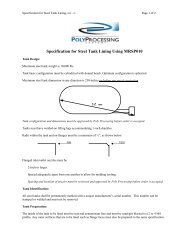Environmental Stress Crack Resistance - Poly Processing
Environmental Stress Crack Resistance - Poly Processing
Environmental Stress Crack Resistance - Poly Processing
You also want an ePaper? Increase the reach of your titles
YUMPU automatically turns print PDFs into web optimized ePapers that Google loves.
If we investigate molecular weight further, we find that all polyethylene resins will becomprised of molecular chains that vary in size or length. This can range from a fewhundred molecules per chain to over a million. For this reason both the number averagemolecular weight and a distribution of the chain lengths are used to characterize apolyethylene resin.A number of analytical tools and tests are used to calculate the number averagemolecular weight and the associated distribution of a polyethylene resin. The Melt Index(MI), or Melt Flow Index (MFI), ASTM D1238, of a molten polymer resin is a generalpredictor or guide for the resin's average molecular weight and distribution. As adefinition, the MI is a measure of the rate at which molten resin, at a preset temperatureand load is extruded from a capillary die. It is measured in units of grams per tenminutes. The MI provides an indication of the average lengths, molecular weights, ofthe molecules in the resin and their level of entanglement since all of these affect theway the polymer flows during the test. In general, the lower the MFI value is for aparticular polyethylene resin grade, the higher its ESCR, see table 1 on page 6 of thisarticle. This is expected since a lower MFI value means the presence of longer chains,including tie molecules in the resin sample. This index is widely used in plasticsindustry, including rotational molding.We can now ask why increasing molecular weight increases ESCR. Since weempirically know that increasing the molecular weight increases the lengths of thechains and thus increasing the proportion of tie molecules in a distribution, we canassume that the ESCR must be improved as the length of the chain increases. Whenspring back occurs because of molecular scission, there is a loss of strength in theinterphase region (there is one less molecule to hold the amorphous and crystallineregions in place). Therefore, the area becomes more susceptible to expansion due tothe degradation defect. This expansion is, of course, the phenomenon that leads to thecreation of micro cracks that are the precursors to stress crack failure. However, if tiemolecules are abundant, these tie molecules are anchored in two crystalline regionsand will, therefore, have a tendency to hold the shape of the interphase region andprevent the growth of the defects. The advantages derived from the tie molecules aregreater as there are more of them. There are more tie molecules in higher molecularweight material. Hence, higher molecular weight improves ESCR.b- Effect of Short Chain Branching (SCB):In reality the long molecular chains that exist in polymers, will have some sectionsalong their chain length that can be more easily incorporated into the crystalline regionsand sections that are noncrystallizable. This is due to the presence of side branches orshort chain branches along the molecular chain. The amount of short chain branchingpresent in the molecular chain depends on the polymerization conditions during themanufacturing of the polymer. Examples of such conditions include catalyst type,pressure, temperature, reactor type, and the concentration and type of co-monomer, ifany.5
















